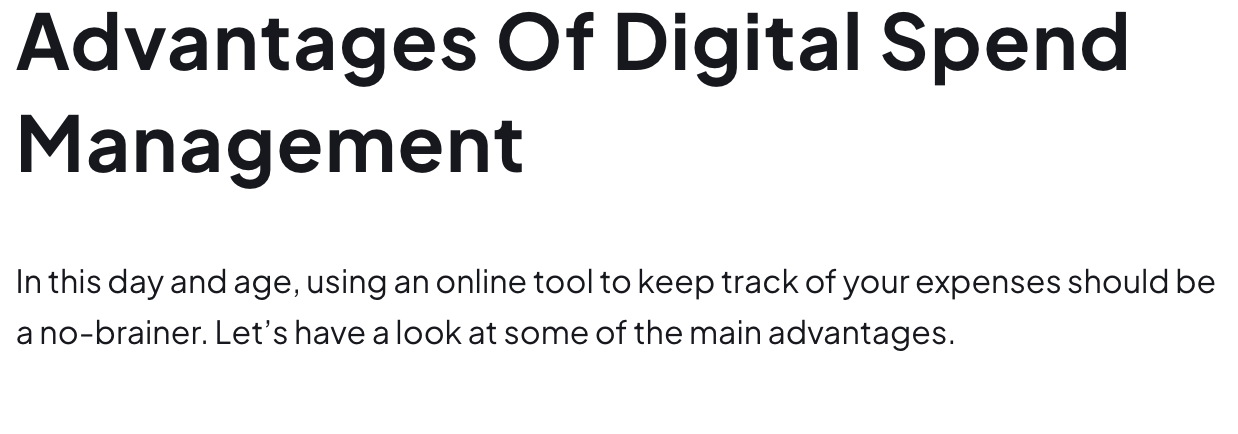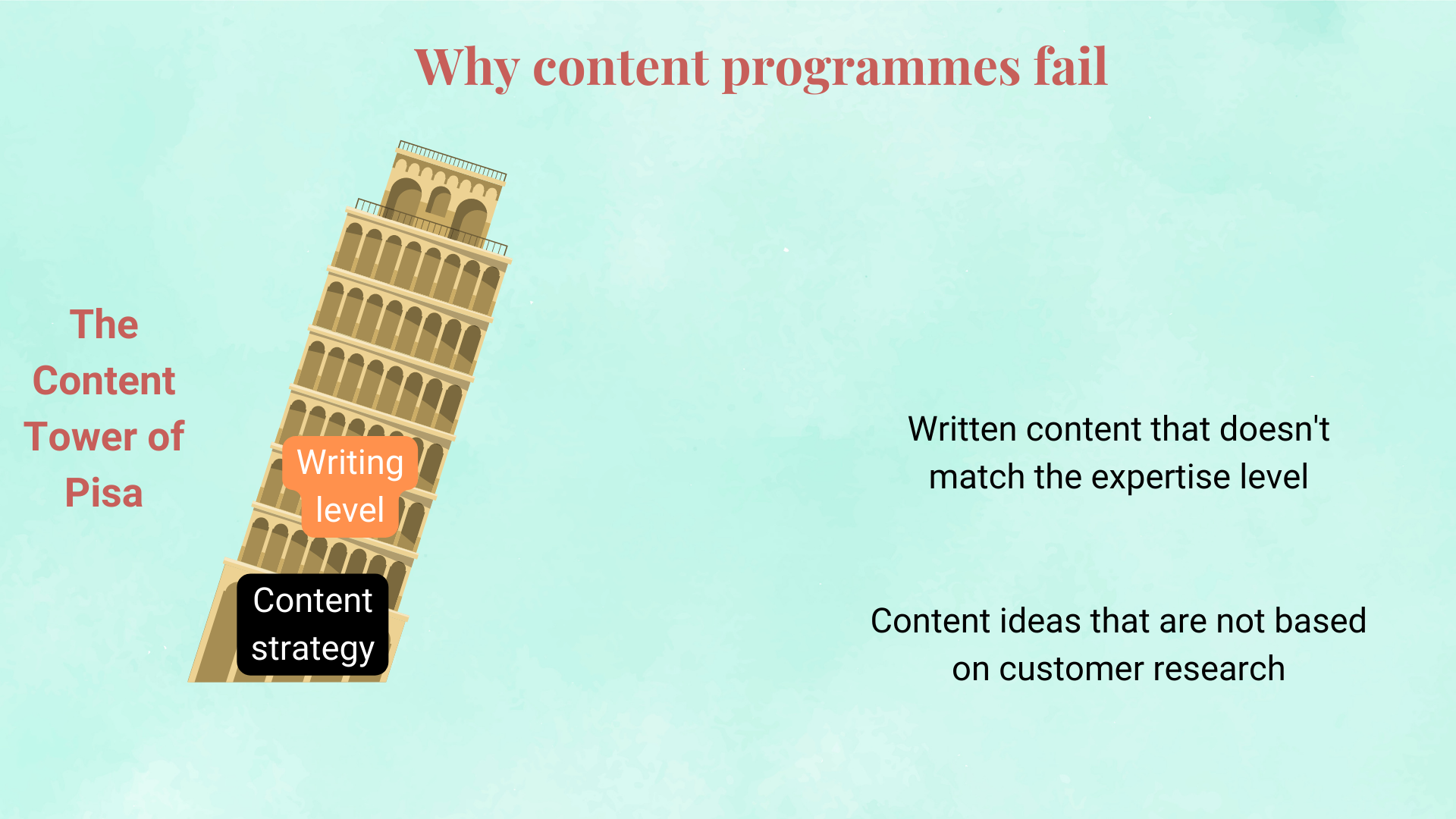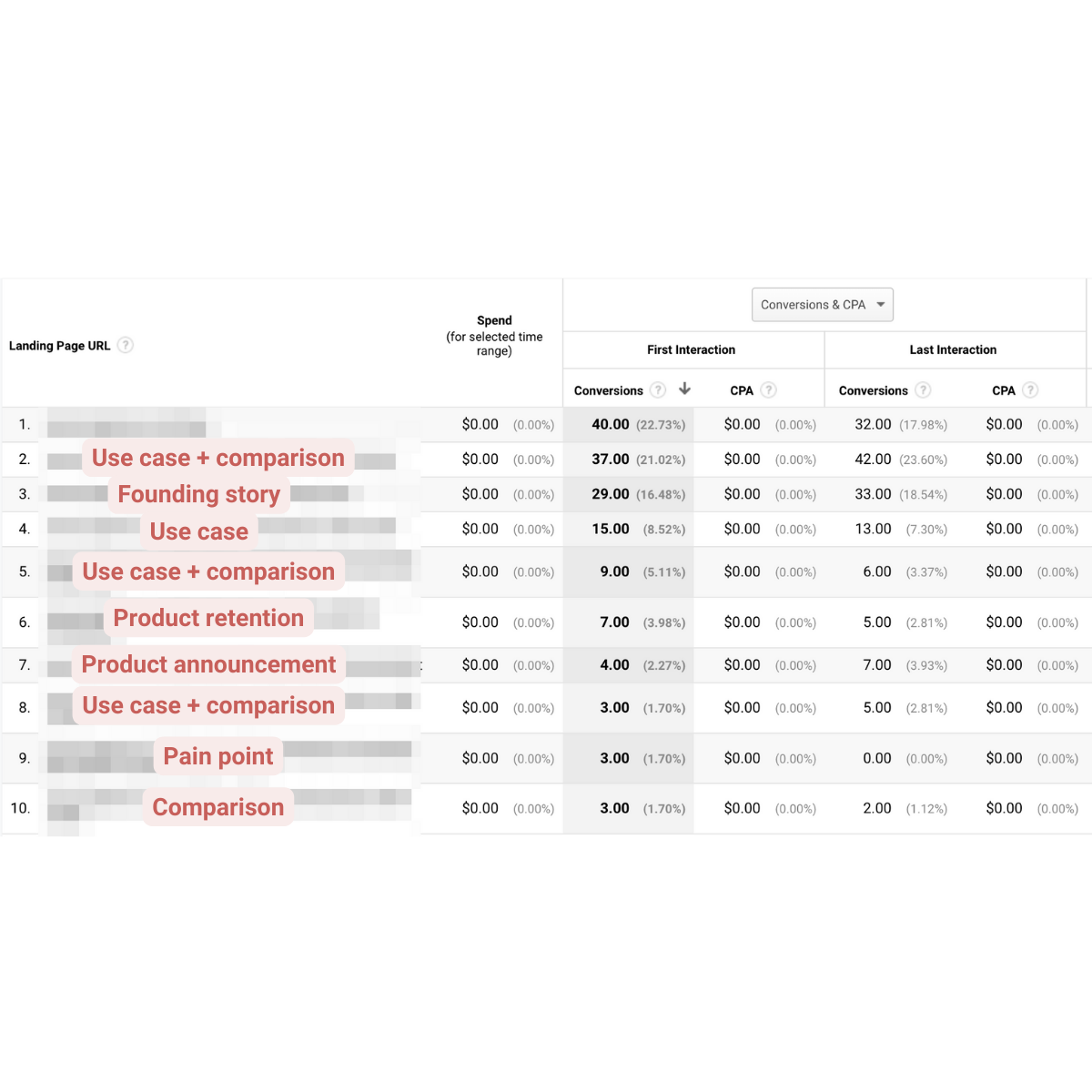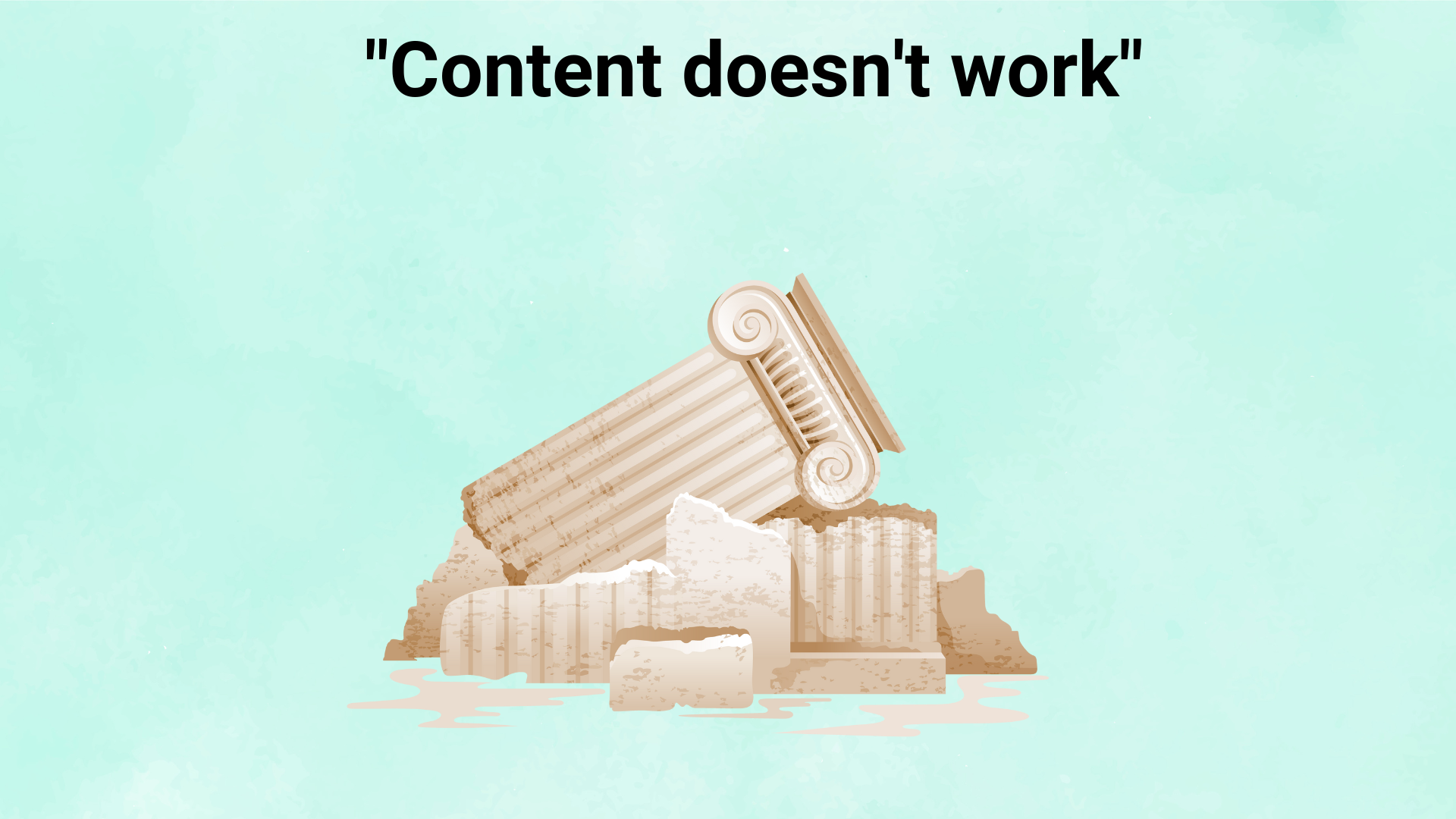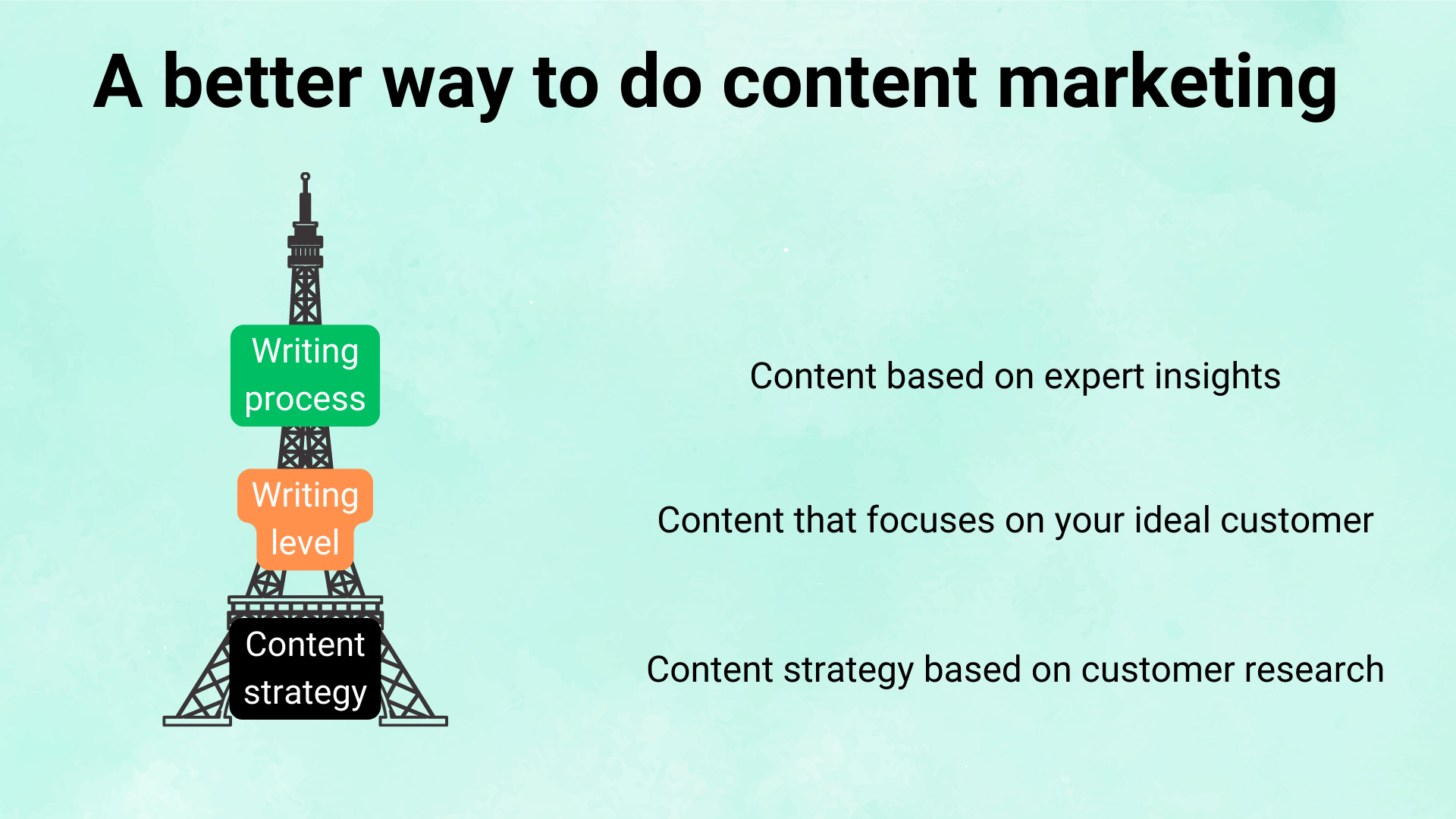The Content Tower of Pisa: Why Fintech Content Programmes Fail
Think carefully about your answer to this question: what’s a B2B fintech company that you believe does great content?
If you’re like most people, you probably don’t have an answer.
That’s because only a handful of B2B fintech companies do great content. Content that people actually want to read, that is inspiring, actionable, useful and interesting – and for the company, brings in business results.
The fact that practically no one can answer this question proves the following: most B2B fintech companies’ content programmes don’t work.
There’s a few reasons why this happens, and we’re going to dive into that in more detail in this article.
But in our experience, the real problem, we’ve found, is that marketers at B2B fintech companies often don’t know where to start when it comes to content. Fintech and payment companies often have a very small marketing team and have a lot of work on their plate – all while being accountable for leads and results.
One of the main pitfalls we find is that when it comes to content, fintech marketers either spend too much time on strategy, organisation, putting together spreadsheets and doing research, rather than executing. Or they outsource the strategy to someone who can only do execution (e.g. freelance writer), which doesn’t tie into the overall strategy.
In this article, we’re going to dive into the four main reasons B2B fintech content programmes don’t work – and a framework to solve for them.
It all starts with: The Content Tower of Pisa.
The Content Tower of Pisa: why content programmes fail
We talk to 3 - 5 new fintech companies every month, and based on those conversations we’ve been able to group the main reasons content programmes fail into four buckets:
Lack of content strategy
Content written for the wrong level of expertise
Writing process that causes misalignment
Lack of tracking results
What’s unfortunate is that if you get the first “bucket” wrong (content strategy), then your content programme is a lot more likely to fail. And that’s why it’s so important to start from the beginning.
Let’s dive into the first one.
Most companies don’t have a systematic approach to coming up with content ideas
When we talk to prospects, one of the pain points we hear time and time again is: we don’t have a solid process to come up with content ideas.
The fact is, very few people have a process for coming up with good content ideas every month that their target market will actually read and that will help them reach marketing goals.
When it comes to coming up with ideas, most people will:
Go through an old, out of date persona document.
Brainstorming with colleagues.
See what competitors are writing about.
Do keyword research based on what competitors are ranking for.
Go through industry newsletters.
What they don’t have, is a solid process that builds a strong foundation for content. They don’t know what their target market would read, they don’t know what their pain points are and they don’t know what the key use cases are.
When you don’t know who your ideal customer is, it’s very hard to create a content strategy. How do you know what to write about if you don’t know what your customer pain points are?
This is the fact: content programmes usually lack a strong foundation because people don’t have a strong understanding of who they should target. And if you don’t know who to target, then it’s even harder to create a strategy.
Without a strong foundation, everything you build after that is more likely to collapse. We’re not off to a good start.
2. A lot of content is not written for the right audience
Imagine that, by luck, you do get the topic right and it turns out to be a relevant topic for your audience. We then get to the next pitfall marketers fall into: writing for the wrong audience.
Instead of writing for their best customer (whom they often don’t know who that is, because they haven’t done the first part), they write for anyone who would be interested in that topic.
Let’s take an example: here we have two companies targeting the keyword “spend management for finance teams”:
Someone searching up “spend management for finance teams” online is clearly in the finance space and might even be in a finance team themselves.
And yet when you click through to Pluto’s article, this is what they start off with:
Someone who works in a finance team does not need convincing on the importance of spend management. Here’s the next section:
Again, a person from the finance team does not care about the advantage of digital spend management.
This is a perfect example of a lost opportunity: perhaps the content team got the topic right, but when you start off an article like this – the reader will immediately click away.
This is the problem with a lot of content out there: it’s written for the wrong person. Grow and Convert call “writing for the right audience” the Customer Content fit, and they use this diagram to illustrate it:
When you’re starting out your content programme, you don’t need to write content for everyone, you should write it for your ideal customer. But because a lot of content programmes haven’t got a solid foundation and didn’t do the initial research, they don’t know who their ideal customer is. And you can’t write for your ideal customer if you don’t know who it is.
And so we have our second part of the Content Tower of Pisa: content that misses the mark and isn’t written for your ideal buyer.
3. Most content writing processes are flawed
Currently, most writing processes follow this approach:
The in-house marketing manager/content marketer decides on the topic and title (which as we’ve seen in #1, might be wrong one) and puts together a “brief”: a document that outlines the title of the article, word count, key topics, two sentences about the persona and the deadline.
The writer researches the topic online, and bases the article on white papers, existing online content and if they’re lucky, some information from the company.
The writer submits the article, the manager reviews and then publishes.
There are a few issues with this process:
The article doesn’t focus on customer pain points: Due to the fact that insufficient customer research has been done and therefore not shared with the writer, the writer doesn’t know what the customer pain points are and therefore who to target. This makes it less compelling for the ideal customer to read.
The article isn’t based on expertise and doesn’t stand out: Since a lot of these articles are based on desk research rather than an expert’s unique point of view, it’s a lot harder for the writer to write something unique and compelling and that stands out from the rest. Why would your ideal customer read your article if they can find the same information elsewhere?
The article can’t go into detail about your product: Since the writer is just given a brief with a couple of sentences on the product and persona, it’s very hard for them to connect the topic to the customer’s pain points or to the company’s product – which makes it a lot harder to convert someone who could be closer to buying and is looking for product information.
In essence, this method of giving a brief to a writer and then hoping they come up with something excellent leads to a huge lack of alignment.
Read more about our thoughts on this here: Why We Believe Hiring Freelance Writers Doesn't Work for Most Companies
You’re now in a situation where the writer doesn’t really understand the customer's pain points, isn’t able to provide an expert point of view and can’t go into detail about the product. So you end up in a situation where you’re publishing this type of content:
And so, we have the third section of our pillar: a writing process that leads to misalignment.
As you can see, our Tower of Pisa is getting very wobbly: we don’t have much of a foundation, we’re probably not writing for the write level of expertise, and on top of that, what we’re writing doesn’t have a unique point of view and won’t really stand out to the reader.
4. Most marketers don’t track the right metrics
Many marketers believe that blog content is mostly for awareness and top of the funnel activities. Or that sales from the blog cannot be tracked, because it’s too inaccurate. This means that very few will track the number of leads and sales their blog brings.
So they track metrics that although are important, don’t give the full picture, such as traffic, engagement and backlinks.
Sure, traffic is important, but an increase in traffic does not always equal an increase in sales.
And this is one of the main issues: because marketers are not tracking sales-related metrics from their content, they have no idea if the content is actually making any impact at all.
With Google Analytics and Hubspot, you can track how many lead conversions you get from your blog content. With each of our clients, we know how many leads we’re generating. Here’s a screenshot with an example:
We can clearly see which blog topics are bringing in the most leads. Don’t you think this is incredibly useful information? We couldn’t imagine trying to come up with a content strategy without having this information.
“What about the quality of the leads?”. If you’ve got Hubspot, you can track who visited your pages and if integrated with Salesforce, you can see the deal size.
Isn’t this incredibly useful information? This is literally telling us that the article on row 4 brought in a confirmed deal (not just a lead) worth $250k. Isn’t that absolute gold?
With this type of information, you can then get a better understanding of which topics are bringing in more qualified traffic and potential customers. This can help influence not only your content strategy, but your overall marketing strategy.
And yet, few marketers seem to be measuring this and could tell you how many leads their content is generating. We couldn’t imagine NOT having this information, because it is SO useful.
Which is often why these content programmes that are missing the first three sections we mentioned above, keep going for years: no one is measuring anything related to sales, so it looks like it’s working. But it’s not.
This is the final section of our pillar, and it’s what ends up toppling everything down:
The result: a content programme that doesn’t work. And a tower that falls apart.
Since the content programme isn’t built on customer research and pain points, you don’t know who you’re writing for and what topics to cover.
Since the content is written for the wrong audience, even if you do get the right topic, the reader won’t convert. And because the writing process is usually based on desk research, there is rarely anything unique or compelling in these articles, which means your ideal customer probably won’t read or remember it.
And to finish off: because no one is tracking sales-related metrics, no one knows how effective these articles really are.
And that’s how you get website blogs full of content that no one reads, that don’t help the company and are a drain on resources.
How we address these issues at Mint Studios
As we mentioned at the beginning of the article, the biggest proof that most B2B fintech companies don’t have effective content programmes is that barely anyone can think of B2B fintech blog they like.
Which is why when our founder Araminta set up Mint Studios, she knew that she could only seriously help fintech companies with their content if she properly rethought the way content is done.
Here’s how we changed it:
1. A systematic approach to content ideas and strategy
Content ideas and strategy have to be based on customer research. You can’t know what to write about if you don’t know what your target reader wants to read.
Since we can’t access customers directly, we do the second best thing: sit down with people who interact with customers on a daily basis. We’ll talk to the sales, product, growth and marketing team to understand the target market.
Before we begin working with a client, we’ll spend a month having discussions with key people on the team, doing interviews.
We try to identify two things:
Understand who are your best customers.
Understand the pain points and challenges.
You can learn more about our process here: How to Do Research for Bottom of the Funnel Content Marketing
After that one month of research, we usually have a solid understanding of who your ideal customer is, what their pain points are and what they might be searching for. We also know what your product strengths and weaknesses are, and what are some content opportunities in the market that we could take advantage of.
Those conversations form the foundation of our strategy and content programme, and they usually provide us with enough ideas to last a year (and after a year, we repeat the process if necessary).
This systematic and methodical process means that we have a repeatable, consistent way of coming up with ideas that we know prospects would be interested in reading.
2. Content written for your ideal customer
Now that we have a strong foundation in place, it’s a lot easier to fix the second problem because we know who your ideal customer is. If it’s Heads of Payments, we know what their pain points are and what they care about. We know which topics and phrases to target, and we know what they would want to read in an article.
Let’s take the same example we used above for “spend management for finance teams”. In our article for Jeeves, we started with:
We immediately kick off by highlighting the pain points CFOs face (which we know because this article is based on an interview with a CFO). If the reader is our ideal customer, they’re a lot more likely to feel heard and understood with this article (and if they're not, then maybe they aren’t our ideal customer – and that’s fine, because we’re not targeting them!).
Since this is a very Bottom of the Funnel article, we don’t go into defining spend management. Instead, we start out directly with our client’s product and explain how the reader can use Jeeves as a finance person.
Again, we’re making sure we’re writing for the right person:
3. Content based on interviews with experts
We solve the third issues in two ways:
Interviews with internal experts.
Questionnaires, not briefs.
To make sure that the content we create is accurate, includes the right information and has a unique point of view, we make sure to create content that is based on interviews with internal experts. That way, we can:
Go into a lot more detail about the product.
Offer a genuinely different point of view.
Speak from the perspective of your company – therefore, positioning you as the expert.
What happens then, is that the article is based on real expertise from someone in your company. This does a much better job of positioning you as the expert and standing out from the crowd.
And secondly, to avoid a situation where writers have to do desk research and don’t understand customer pain points, we ask them to fill in the “brief”.
Based on the interview with the expert, they fill in the brief themselves. We ask them to figure out what they think the customer pain points are, what features and benefits to highlight and how to make sure we match the intent of the searcher. This helps with alignment and helps create quality content that is actually read by your ideal customer.
Read more: Are Content Briefs the Spawn of Satan?
Our Tower is a lot stronger now. In fact, it’s no longer a Tower of Pisa; it’s an Eiffel Tower.
We have a strong foundation based on customer research
Our content is written for our ideal customer, not just everyone
Our content has a unique point of view
4. We track the results
Finally, all this is for nothing if we don’t know what worked and what didn’t. Did this article on X topic bring in more qualified traffic? You can only know this if you’re tracking lead conversions from your content.
We use Google analytics or Hubspot to track the number of leads our content generates. Every month, we can share a report and we know how many leads and new business our content generated. Here’s an example of a payment client where we’re bringing multiple customers per month:
And ultimately, this feeds into our strategy. If we see that this comparison post did very well, then it might indicate that we do more comparison posts
Hopefully this article clearly demonstrates the issues with most content programmes, and how we solve for them at Mint Studios.
Avoid the Content Tower of Pisa, and build an Eiffel Tower: make sure you’ve got a strong foundation, your content is written for the right audience, it comes from a place of expertise and that you’re actually tracking the results – and your content programme will thrive.
Most companies are operating content the old way. Which leads to terrible SEO content that no one reads, that is embarrassing, and doesn’t help get results. These issues clearly illustrate that in order to content well, we need to completely rethink how to do content and how to approach content. By doing it differently, we can get much better results.





